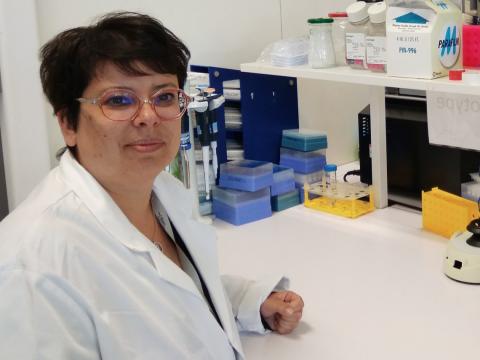
Christine Baldeschi: skin grafting
In her laboratory at the Stem Cell Institute for the treatment and study of monogenic diseases (i-Stem - Inserm/University d’Evry), Christine Baldeschi manufactures skin cells from stem cells for the purpose of grafting an epidermis onto patients suffering from rare genetic skin diseases. Upcoming clinical trials are a world "first".
Affiliated with the AFM Telethon, i-Stem is a university laboratory created by Marc Peschanski in 2005. The teams are working on the treatment and understanding of genetic diseases using stem cells of embryonic origin, or of induced pluripotency, taken from the patient. For the past twelve years, Christine Baldeschi has led the team studying genodermatoses, rare genetic skin diseases. Based on protocols, the researcher carries out either cell therapy or pathological modelling of genetic skin diseases in order to find treatments.
Immortal and pluripotent cells
Embryonic stem cells, collected five to seven days after in vitro fertilization and cultured "have two characteristics: they are "immortal" and self-renewing indefinitely, and "pluripotent", i. e. they will give all the cell types of the body: brain, skin, muscle...", explains Christine Baldeschi, who develops protocols to then differentiate these pluripotent stem cells into skin cells, keratinocytes, melanocytes or fibroblasts.
Grafting an epidermis by 2022
Once differentiated into keratinocytes, the cells will be used to reform an epidermis. "We are currently setting up a clinical trial that will make it possible to graft an epidermis on patients suffering from sickle cell disease. This rare genetic disease affects one in 30,000 children and causes leg ulcers. There is currently no treatment." The idea is to use this in vitro reconstructed skin as a healing dressing. Protocols for the production of human-compatible cells are currently being tested with the pharmaceutical industry. "We have never been so close to being able to treat patients," says the researcher.
Reprogramming the cells
Christine Baldeschi also carries out pathological modelling on epidermolysis bullosa, another rare genetic disease that affects children and is responsible for the detachment of their skin. "In this case, we apply a cocktail of transcription factors directly to the patient's blood cells. This cocktail reprograms the blood cells in a pluripotent state and these cells have the same characteristics as embryonic stem cells," explains the researcher, who works directly with the medical team at Necker Hospital. "By studying diseased keratinocytes, we are trying to understand the molecular mechanisms associated with this disease in order to perform pharmacological screening: we are testing existing drugs to to find the right therapeutic formula. »
Nice, Glasgow, Evry
After a master's degree in cellular and molecular biology at Nice Sophia Antipolis University, Christine Baldeschi continued with a thesis, the subject of which already dealt with a skin genetic disease. She supported it in 2004 and went on to do a post-doctoral fellowship in Glascow. She returned earlier than expected to France, to Université d’Evry, where she obtained a position as a lecturer in September 2006, at the age of 29! A year later, she took over the management of her current team at I-Stem. "I immediately benefited from the confidence of the Director of the Institute. "Today, the young researcher is responsible for M2 tissue, cell and gene biotherapy and in turn is passing on the torch of research. "It is a great pride to know that one of my students was admitted to Harvard as a post-doctoral fellow!"
Christine Baldeschi

